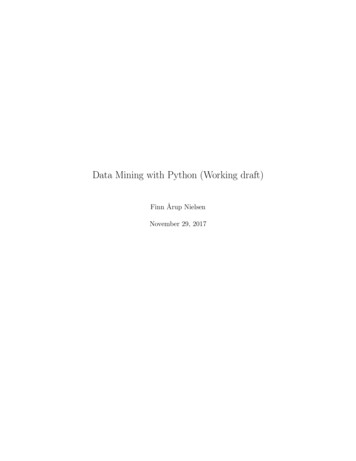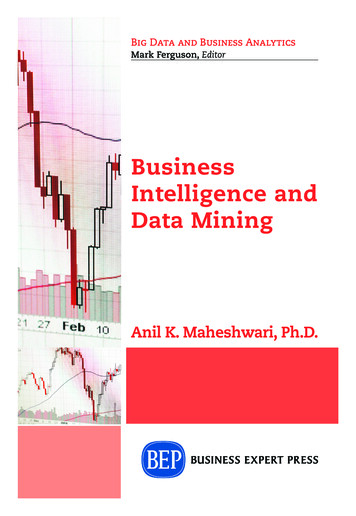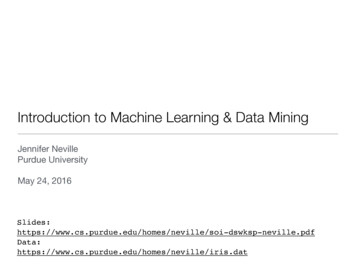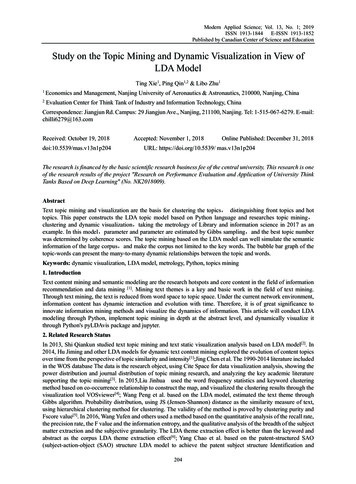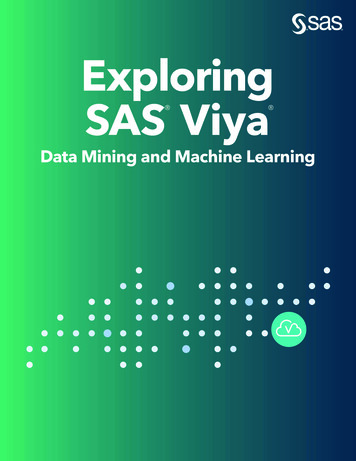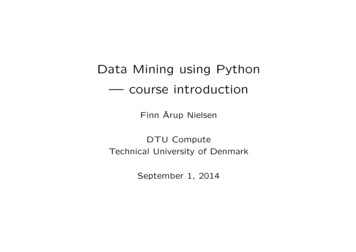
Transcription
Data Mining using Python— course introductionFinn Årup NielsenDTU ComputeTechnical University of DenmarkSeptember 1, 2014
Data Mining using Python — course introductionData Mining using PythonDTU course 02819 Data mining using Python.Previously called DTU course 02820 Python programming (study administration wanted another name).Project course with a few introductory lectures, but mostly self-taught.Deliverables: A report, a poster and an oral presentation at the posterabout a Python program you write in a group.Teacher: Finn Årup NielsenFinn Årup Nielsen1September 1, 2014
Data Mining using Python — course introductionTentative schedule for autumn 20141. September Installation8. September. Introduction to the Python language.15. September. Numerical NumPy, SciPy, MatPlot (“Python as Matlab”)22. September. Databasing, web and text processing, “natural languageprocessing”29. September Misc., e.g., GUI, Web servingProject work for the rest of the timeDecember: Exam and report hand-inSee links to PDF on http://www.compute.dtu.dk/courses/02820/Finn Årup Nielsen2September 1, 2014
Data Mining using Python — course introductionOther coursesIntroductory programming andmathematical modelling (linear algebra, statistics, machine learning)Some overlap with 02805 (Social graphs and interaction),02806 Social data analysisand visualization, 02821 (Webog social interaktion) and02822 (Social data modellering).If you take several 028xx courses be sure that you do not make a projectthat overlaps with projects in these courses in any way!Finn Årup Nielsen3September 1, 2014
Data Mining using Python — course introductionProjectProject: (Idea), design, implementation, testing, documention.Performed preferably in groups of two persons. Three is also ok.Should preferably contain components of: Mathematical (numerical, computational, statistical or machine learning) modeling Internet/data/text miningFinn Årup Nielsen4September 1, 2014
Data Mining using Python — course introductionPosterConstruct a poster. Often A0/A1-sized.“Defend” the poster, i.e., give a relativelyshort oral presentation of the poster andanswer questions: Usually a ten minutespresentation for a two-person group withsome questions afterwards.Inspired from DTU course 02459 MachineLearning for Signal ProcessingFinn Årup Nielsen5September 1, 2014
Data Mining using Python — course introductionWhy Python?Interpreted, readable (usually clearer than Perl), interactive, many libraries, runs on many platforms, e.g., Nokia smartphones (hmmm. . . )and Apache Web servers.With Python one can construct numerical programs, though with a bitmore boilerplate than Matlab.Google and Yahoo! is (has been?) using it. 2.73% of Open Source codewritten in Python (Black Duck Software, 2009).“Without [Python] a project the size of Star Wars: Episode II would havebeen very difficult to pull off.” — http://python.org/about/quotes/XKCD 353: “I wrote 20 short programs in Python yesterday.wonderful. Perl I’m leaving you.”Finn Årup Nielsen6It wasSeptember 1, 2014
Data Mining using Python — course introductionFinn Årup Nielsen7September 1, 2014
Data Mining using Python — course introductionWhy Python? Interactive language!Interactive session pythonPython 2.4.4 (#2, Oct 22 2008, 19:52:44)[GCC 4.1.2 20061115 (prerelease) (Debian 4.1.1-21)] on linux2Type "help", "copyright", "credits" or "license" for more information. 1 12However, Matlab-like computation is not straightforward, e.g., what isthe result of 1/2Finn Årup Nielsen8September 1, 2014
Data Mining using Python — course introductionWhy Python? Interactive language!Interactive session pythonPython 2.4.4 (#2, Oct 22 2008, 19:52:44)[GCC 4.1.2 20061115 (prerelease) (Debian 4.1.1-21)] on linux2Type "help", "copyright", "credits" or "license" for more information. 1 12However, Matlab-like computation is not straightforward, e.g., what isthe result of 1/20Finn Årup Nielsen# Integer division! (in Python2 --- not Python3)9September 1, 2014
Data Mining using Python — course introductionExample projects for inspiration1. Characterize external links from DTU’s Web-site.2. Characterize internal link structure on DTU.3. A search engine for DTU Web-pages.4. Sentiment analysis of Tweets, blogs or news articles.5. A wiki-based database for brain activations6. A Web-service for visualization of brain activations.7. Suggest one yourselfFinn Årup Nielsen10September 1, 2014
Data Mining using Python — course introductionHow do we evaluate the project?Possible dimensions for evaluation of project?Finn Årup Nielsen11September 1, 2014
Data Mining using Python — course introductionCoding styleBad: Variables are given incoherent names. Indentations are inconsistent.Good: Variables are given intuitive and readable names. Code has beenchecked with flake8 and pylint.Finn Årup Nielsen12September 1, 2014
Data Mining using Python — course introductionEvaluation: Reusability of codeBad: Input variable values are hard-coded. Code is repeated to make itlook ‘big’.Good: Code is in meaningful modules. It is no problem to apply the datamining on new data. Part of the code can be used in other contexts.Finn Årup Nielsen13September 1, 2014
Data Mining using Python — course introductionEvaluation: Amount of dataBad: The system is only able to handle a small amount of prespecifieddata and not likely anything else.Good: The system use a ‘large’ amount data. The system use a databaseor other structured way of accessing a large amount of data.Finn Årup Nielsen14September 1, 2014
Data Mining using Python — course introductionEvaluation: Data mining effortBad: Simple analysis is performed. No use of Numpy, Scipy or other datamining package. Data is just entered, stored and ‘copied around’.Good: Machine learning or other complex analysis is performed.Finn Årup Nielsen15September 1, 2014
Data Mining using Python — course introductionEvaluation: TestingBad: No tests.Good: A part of the code is tested.Better: As much as feasible of the code is tested and with a variety ofinput and with the standard tools of Python testing. Testing coverageis computed and reported. Testing is performed on multiple versions ofPython.Finn Årup Nielsen16September 1, 2014
Data Mining using Python — course introductionEvaluation: DocumentationBad: There is no documentation. No use of docstring.Good: Docstrings are used.Better: Docstrings are used and used according to Numpy and otherconventions. The documentation is checked with the pep257 programand no errors are found. Online documentation is generated with sphinxis available.Finn Årup Nielsen17September 1, 2014
Data Mining using Python — course introductionEvaluation: ‘Well-presented’ resultsBad: A plot in Excel is used with unlabeled axes.Good: Data analysis results and other presentation with a number ofPython tools, Matplotlib, etc., utilized in depth.Better: A responsive interactive environment (perhaps web-based) ismade where the user can navigate the result such zooming and panningas well as get the data results in a suitable format for further processing.Finn Årup Nielsen18September 1, 2014
Data Mining using Python — course introductionEvaluation: other dimensionsEffective and ‘good’ code. Shows a good command of Python . . .Amount of code (but not code that is constructed to look big, by unnecessary repetitions and bad implementation).Relevance of project: Is there a interesting (scientific) result or possibilityfor commercial application?Originality of project . . . !?Finn Årup Nielsen19September 1, 2014
Data Mining using Python — course introductionMore informationLearning objective: “Identify relevant learning material”. You yourselfneed to identify the appropriate Python documentation!http://www.python.org/The Python Tutorial http://docs.python.org/tutorial/Internet search engines: Google, Bing or Yahoo.Stack Overflow, . . .Google for error messages, “Python tutorial”MATLAB commands in numerical Python (NumPy) by Vidar BronkenGundersen if you know Matlab or R.Finn Årup Nielsen20September 1, 2014
Data Mining using Python — course introductionFree booksDive into Python, (Pilgrim, 2004). Free, old and good.With sudo aptitude install diveintopython it is available htmlThink Python: How to Think Like a Computer Scientist and How toThink Like a Computer Scientist. Covers the basics of the Python language and Tkinter GUI. Also available as Wikibooks: Think Python andHow to Think Like a Computer Scientist: Learning with Python 2ndEdition.Finn Årup Nielsen21September 1, 2014
Data Mining using Python — course introductionGeneral booksPractical Programming. An introduction to computer science using Python,(Campbell et al., 2009): Introductory programming. Good if you are unsure.Python cookbook (Martelli et al., 2005): Short program examples forsomewhat specific problems. Too specific.Finn Årup Nielsen22September 1, 2014
Data Mining using Python — course introductionSpecialized books relevant for the courseProgramming collective intelligence (Segaran, 2007): Python and machine learning with data from the Web.Natural language processing with Python (Bird et al., 2009): Text miningwith Python. On paper and available online from http://nltk.orgProgramming the Semantic Web (Segaran et al., 2009)Mining the Social Web (Russell, 2011) Used(?)Maybe good.in on DTU courses.Bioinformatics Programming Using Python, (Model, 2009). Introductorybook to Python programming with emphasis on bioinformatics.Finn Årup Nielsen23September 1, 2014
Data Mining using Python — course introductionData analysis and numerics booksKevin Sheppard’s Introduction to Python for Econometrics, Statistics andData Analysis on 381 pages covers both Python basics and Python-baseddata analysis with Numpy, SciPy, Matplotlib and Pandas, — and it is notjust relevant for econometrics (Sheppard, 2014).(Langtangen, 2005; Langtangen, 2008): Python book with many examples especially for numerical processing. 2005 edition not fully up to dateon numerical Python. 2008 version should be available online throughDTU libraryMy draft Data Mining with Python.Finn Årup Nielsen24September 1, 2014
Data Mining using Python — course introductionOther booksOther O’Reilly titles: Python in a Nutshell, Python Pocket Reference,Learning Python, Programming Python?Other books that I know of:Mobile Python (Scheible and Tuulos, 2007): On Nokia smartphone. Deadend.Python Essential References (Beazley, 2000): Introduction and list ofPython functions with small examples. Somewhat old and not recommendable.Finn Årup Nielsen25September 1, 2014
Data Mining using Python — course introductionExample: A fielded wiki . . .Web script in Python implementing a fielded wikifor personality genetics.Persistence with a smallSQLite database.Some of the Python libraries used: cgi, Cookie,math, pysqlite2, scipy, sha.One Python script with2269 lines of code.Finn Årup Nielsen26September 1, 2014
Data Mining using Python — course introductionExample: . . . A fielded wikiComputation of effect sizes (a statistical value) and comparison to statisticaldistributions.Generation of interactive and hyperlinkedplots in SVG (anXML format)Finn Årup Nielsen27September 1, 2014
Data Mining using Python — course introductionStructured information from WikipediaGet Wikipedia pages thatcontain a specific template,download the page, extract information from the templatesand render the result on anHTML page.Python libraries: json, re, urllib2Around 25 Python lines to getthe data, and around 120 torender the result.Finn Årup Nielsen28September 1, 2014
Data Mining using Python — course introductionWeb script for Twitter annotationCGI program that searchesTwitter with a user-definedquery, obtain tweets andpresent them in a Web formfor manual annotation andstores the result in a SQLdatabase.Python libraries: codecs, json,re, cgi, urllib2, pysqlite2, xml.500 Python lines.Finn Årup Nielsen29September 1, 2014
Data Mining using Python — course introductionTemporal sentiment analysisDownload tweets from Twittermicroblog searching on ’COP15’(United Nation climate conference in December 2009)Compare words against a wordlist with valence (positive/negative) valence for each word.Sum up positive and negative valence for each day and plot agraph.Python libraries:simplejson, . . .Finn Årup Nielsen30SQLite,re,September 1, 2014
Data Mining using Python — course introductionOnline topic-sentiment mininghttp://neuro.imm.dtu.dk/cgi-bin/brede str nmfFinn Årup Nielsen31September 1, 2014
ReferencesReferencesBeazley, D. M. (2000). Python Essential Reference. The New Riders Professional Library. New Riders,Indianapolis.Bird, S., Klein, E., and Loper, E. (2009). Natural Language Processing with Python. O’Reilly, Sebastopol,California. ISBN 9780596516499.Campbell, J., Gries, P., Montojo, J., and Wilson, G. (2009). Practical Programming: An Introduction toComputer Science Using Python. The Pragmatic Bookshelf, Raleigh.Langtangen, H. P. (2005). Python Scripting for Computational Science, volume 3 of Texts in Computational Science and Engineering. Springer. ISBN 3540294155.Langtangen, H. P. (2008). Python Scripting for Computational Science, volume 3 of Texts in Computational Science and Engineering. Springer, Berlin, third edition edition. ISBN 978-3-642-09315-9.Martelli, A., Ravenscroft, A. M., and Ascher, D., editors (2005). Python Cookbook. O’Reilly, Sebastopol,California, 2nd edition.Model, M. L. (2009). Bioinformatics Programming Using Python. O’Reilly, Köln. ISBN 978-0-596-154509.Pilgrim, M. (2004). Dive into Python.Russell, M. A. (2011). Mining the Social Web. O’Reilly. ISBN 978-1-4493-8834-8.Scheible, J. and Tuulos, V. (2007). Mobile Python: Rapid Prototyping of Applications on the MobilePlatform. Wiley, 1st edition. ISBN 9780470515051.Segaran, T. (2007). Programming Collective Intelligence. O’Reilly, Sebastopol, California.Segaran, T., Evans, C., and Taylor, J. (2009). Programming the Semantic Web. O’Reilly. ISBN 978-0596-15381-6.Sheppard, K. (2014). Introduction to Python for Econometrics, Statistics and Data Analysis.published, University of Oxford, version 2.1 edition.Finn Årup Nielsen32Self-September 1, 2014
Data Mining using Python course introduction Data Mining using Python DTU course 02819 Data mining using Python. Previously called DTU course 02820 Python programming (study admi



